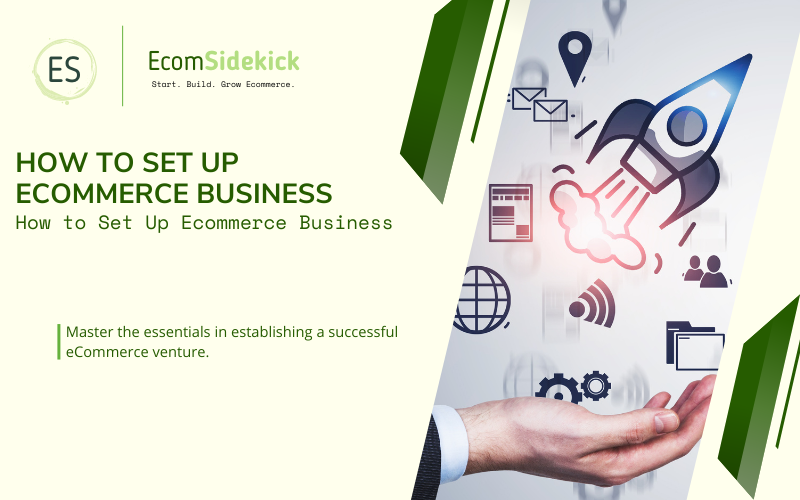Want to know how to set up ecommerce business? This is the critical step where people usually get stuck. However, just as the setup piece is important, the overall understanding of how to build an ecommerce business from a high level overview is also key.
Understanding this, allows you to see how ecommerce businesses are built and typical tech stacks that are used. Then that is the time to zoom in on the actual setup.

At the end of the day, with some help, it is easier than you might initially think, but it does take planning! To find out everything you need to know and get started today, just keep reading.
How To Set Up Ecommerce Business?
Decide On Your Business Model
If you already have an idea of what you would like to sell, it’s time to come up with a business model. A business model is the foundation of your startup, and something you need to take seriously. Here, you will decide on the logistics and the whole model going forward.
There are four traditional business models that you can pick from, but you need to find out which one is right for you. The traditional business models are:
- Business-to-Business (B2B) – goods are sold directly from one business to another (e.g. CRM Software).
- Business-to-Consumer (B2C) – goods are sold from a business to a consumer (e.g. HelloFresh).
- Consumer-to-Consumer (C2C) – goods are sold from one consumer to another (e.g. Etsy).
- Consumer-to-Business (C2B) – goods are sold from a consumer to a business (e.g. freelance work)
Pick Your Value Delivery Method
How, you will need to decide how you will actually be delivering your goods to whoever you’re selling them to. This includes considering the supply chain logistics, the brand, packaging, and much more. The option you go with might depend on the goods you’re selling, or services you’re offering. Some of the best value delivering options are as follows:
- Subscription
- Dropshipping
- White Labeling
- Private Labeling
- Wholesaling and Warehousing
Research
Never run in blind. You need to do your research beforehand so that you know what you’re getting into, and what needs to be done. To be successful, you will need to do a lot of research on the following things:
- Target audience – who are you trying to sell your goods to? Is there a particular demographic? Find out the purchasing power of this group of people, and why they will want your product. This can influence the themes, colors, images, and overall design of your brand to make it more appealing to that chosen demographic. You do NOT have to hire an expensive full time designer. You can look at sites like Canva and 99Designs to get this job done.
- Competitors – you need to have competitors, or else there probably isn’t a market for your goods or services. Research and study your competitors on sites like Ahrefs and Moz, to see what they’re missing, and what you can do better. This will expose all the gaps in the market and give you a good chance of being even more successful than them.
- Suppliers – unless you are only creating digital products that require no suppliers, this is a crucial step. Find out who can be your supplier, get quotes, and pick the right one for you. You will need to find out about packaging, delivery, costs, and so much more.
- Products – what products will you be selling? Be specific, and make sure that they are products that your target audience will want. Small items with high values are great for space, but you will need to find that suits you. A good spot to look for wholesale products are sites such as Alibaba or DHgate.
- Shipping – find out what you need to know about shipping, and whether you will do international shipping initially. Learn the prices, rules, and regulations surrounding it.
Browse these resources to help you design your brand and overall site:
- Canva vs Adobe: Which One is Better for Your Small Business
- Canva vs InDesign: Which is Best for Your Business
- Piktochart vs Canva
Write Up A Business Plan
A business plan is essentially a blueprint to follow for your business. This should outline how your business will turn a profit and remain successful. Outline what you will do, and how you will do it. Be precise, and add detail where you can.
Decide On Your Business’ Legal Status

This is so that the government knows what you are, and can treat you accordingly. You will need to let your government know that your business is about, who’s in charge, and more. It will also help with taxes when the time comes. There are four options to go with:
- Limited Liability Partnership – a business partnership, but the company and associated finances are a separate entity to you.
- Limited Liability Company – a private company where assets of the shareholder are protected and liability is limited by how much is invested.
- Partnership – you share profits and management with another individual.
- Sole Trader – you alone are responsible for all profits and losses.
Setup an Online Bank Account
Traditional banks are expensive and slow. It is always good to look at some online banking options for convenience and speed. At the very least know the options. Some banks that are out there and popular are Ally and Chime.
Register And Trademark The Name Of Your Company
Now you need to decide on a business name and logo! Make sure that these reflect what the business is about and who you are. When you finish that, you will need to register all the information to make it legal. You can also trademark your business name and logo for a fee. This will protect you and your brand from being ripped off by other merchants.
Build Your Online Shop
Building your online ship can be tricky, but it doesn’t have to be difficult. You can get it built professionally, or use software like Wix to build one easily. Alternatively, you could code your own site, or use a CMS such as WordPress. But for that, you will need to choose a hosting provider.
- Shopify
- Wix
- Squarespace
- CMS (such as WordPress)
Time To Start Taking Payments
Now, you need to start setting up and taking payments. Popular options like Business Venmo or PayPal can be used. WorldPay is another good one. There are plenty of great options, but make sure they have a payment gateway to authorize and verify transactions.
Make sure the payment gateway accepts a wide range of cards, is affordable, easy to use, and integrates with your website.
Marketing Is Key
To get business, you need to market. This can be difficult, but it’s always worth the effort. You can follow the below tips to help you with marketing. Be aware that the type of business you run will impact the marketing approach you take, so consider what your target audience will prefer and see.
- Use Social Media to Advertise
- Team Up With Influencers and Accounts
- Have a Strong SEO Strategy
- Use the Correct Email and Landing Page Software (something like ClickFunnels or ConvertKit)
- Run Deals and Special Offers
- Build and email marketing list (something like SendGrid or Mailchimp)
Business owners often times do not focus on building an email list. This is one of the biggest mistakes when starting out. So you can get a feel for the features and benefits of different email platforms, here are a few related articles to help you out.
- Active Campaign vs ConvertKit
- Flodesk vs ConvertKit
- ConvertKit vs GetResponse
- GetResponse vs Mailchimp
- ConvertKit vs Mailchimp
Now, on to outsourcing.
Start Outsourcing
When your business starts to grow, you will need to start outsourcing. You can outsource anything from labor to physical products. New processes will have to be implemented, and other companies may need to be hired to help you!
This is a good thing, but be careful when you approach this line. Just be aware that a growing business will need more help, and be prepared to get that help when the time is right.
Final Thoughts

Setting up an ecommerce business can be done in 10 (relatively) simple steps! Be sure to get more information from your country and state, as rules and regulations might differ.
Other Related Resources:
- Hubspot vs Mailchimp: Side-By-Side Comparison
- Mailchimp vs Flodesk: Pick the Right Tool for Your Email Marketing
- ConvertKit vs. AWeber: Which One Is Best
Frequently Asked Questions
Is Setting up an Ecommerce Business Easy?
Setting up an ecommerce business is daunting, but it also isn’t as difficult as you might think. Anyone can do it as long as they take time to make sure it is done right.
How Long Does It Take To Set up an Ecommerce Business?
It can take less than a week to set up a fully fledged ecommerce business. Times might vary depending on where you live and what you plan to sell, but the whole process shouldn’t take longer than a week if you work hard at it.
Should I Set up an Ecommerce Business?
If you have a passion for something, see an opportunity, and know you can handle it, go for it! Make sure you have the funds to invest, and make smart decisions. Anyone can set up an ecommerce business, and you don’t need to have a degree to do it, especially if you have people to help you.
Paul Martinez is the founder of EcomSidekick.com. He is an expert in the areas of finance, real estate, eCommerce, traffic and conversion.
Join him on EcomSidekick.com to learn how to improve your financial life and excel in these areas. Before starting this media site, Paul built from scratch and managed two multi-million dollar companies. One in the real estate sector and one in the eCommerce sector.

